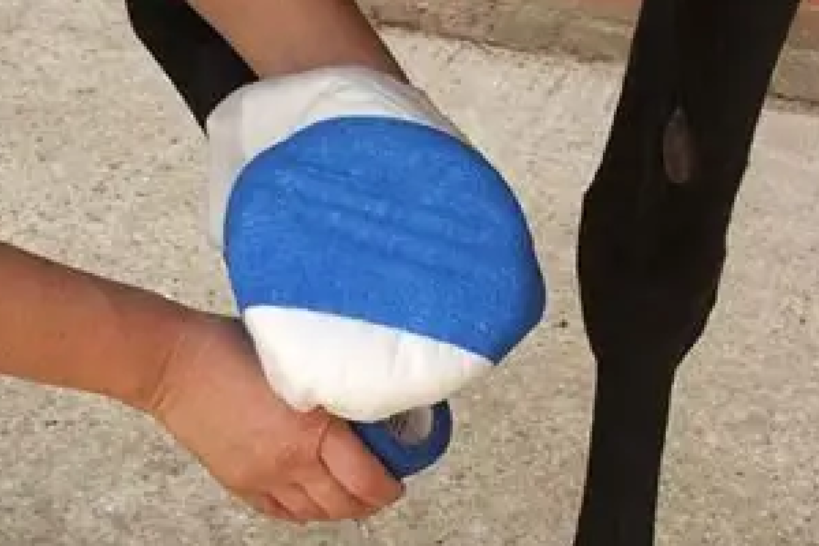My horse has an abscess. Now What?
A hoof abscess can cause sudden, scary lameness, but don’t panic. With the right care, soaking, poulticing, and rest most heal quickly. Know the signs, help it drain, and call your vet or farrier if needed.

Have you ever woken up to find your horse suddenly lame, barely putting weight on a hoof, and you're thinking, "What in the world just happened?!" A common culprit behind this dramatic lameness is often a hoof abscess. It's a painful infection, but with the right steps, your horse can be back to normal in no time. Let's break down what you need to know if you suspect your horse has one!
What Exactly Is a Hoof Abscess?
Imagine a small, very painful zit inside your horse's hoof! A hoof abscess is basically a localized pocket of pus that forms between the sensitive inner layers and the hard outer hoof capsule. This pus builds up pressure in the rigid hoof, leading to that sudden, severe pain your horse is showing. Bacteria, dirt, gravel, or other foreign materials usually get inside the hoof through a small crack, puncture, or separation in the sole-wall junction (that white line you see on the bottom of the hoof), or even a misplaced horseshoe nail. Once inside, these unwelcome guests cause an inflammatory response, leading to the formation of pus.
How to Spot the Signs: Your Detective Work
Hoof abscesses can be sneaky, but they often give themselves away with clear signs:
Sudden, Severe Lameness
This is often the first and most obvious sign. Your horse might go from completely fine to barely weight-bearing, sometimes even looking like they've broken a leg. The lameness can range from mild to non-weight bearing.
Increased Digital Pulse
Feel for the digital pulse around your horse's pastern. With an abscess, it will likely be stronger, or "bounding," and possibly more intense on the affected side.
Heat in the Hoof or Leg
The affected hoof or even the limb (pastern, up to the knee or hock) might feel warm to the touch compared to the other legs.
Swelling
You might see some soft tissue swelling around the heel bulbs, coronary band, or pastern, sometimes extending higher up the leg.
Pus Drainage or Foul Odor
Eventually, the abscess might "break out," either through the sole or, sometimes, at the coronary band, releasing a gray or black pus. You might also notice a foul smell.
Foreign Object
If you see a nail, screw, piece of glass, or a sharp stone embedded in the sole, DO NOT REMOVE IT! This is very important.
Your Immediate Action Plan: What to Do and Not Do!
Stay Calm & Assess
Take a deep breath. Observe your horse's lameness and check for the signs mentioned above.
Call Your Professionals IMMEDIATELY
This is the most crucial step! Contact your veterinarian and your farrier right away.
While farriers often treat hoof abscesses, if there's any chance of a deep infection, involvement of sensitive tissue, or foreign objects, a veterinarian should be involved.
Why is professional help so important? A vet can use hoof testers to pinpoint the exact painful spot. They might also take radiographs (X-rays) if a foreign object is present or if the lameness is severe to understand the depth and direction of the problem and check for damage to bone.
DO NOT Remove Any Embedded Objects!
If you find a nail, sharp rock, or other object stuck in the hoof, leave it in place. Your vet needs to see its exact location and angle to assess the damage and ensure it's fully removed. Pulling it out yourself can make diagnosis harder and potentially introduce more bacteria.
Clean the Hoof (Gently)
You can carefully clean the solar surface of the affected hoof with a wire brush. This helps your vet or farrier get a better look.
Relieve Pressure (if instructed)
Sometimes, your vet might suggest applying a poultice or soaking the foot.
A common method is a warm poultice (like Animalintex®) applied to the foot, which helps soften the area and encourage the abscess to "point" or drain. You soak the poultice in hot water, squeeze out the excess, place it on the foot, and secure it with gauze, a cohesive bandage, and waterproof tape. Make sure the whole foot, including the coronet, is covered.
Another option is a "soak bandage" saturated with warm water and Epsom Salts (MgSo4). Epsom salts help draw out the infection.
Important: Avoid "oversoaking" as it can weaken the hoof. Follow your professional's specific instructions.
The Role of Your Vet & Farrier: Drainage is Key!
The main goal in treating a hoof abscess is to establish drainage. This relieves the painful pressure and allows the infection to clear.
How Professionals Drain It
Your vet or farrier will carefully explore the sole-wall junction or the area of pain using specialized tools like a loop knife or bone curette. They follow the small tract until pus is released. They aim for an opening just big enough for drainage, avoiding excessive damage or exposing sensitive tissue.
Drainage may be established through the sole-wall junction or a small channel created on the hoof wall side. Some veterinarians/farriers do not like to approach a routine abscess through the sole itself due to risks like hemorrhage or persistent wounds.
Other veterinarians/farriers commonly pare out the abscess through the sole using a hoof knife, allowing gravity to aid in clearing the pus.
Regardless of the exact method, this is a skilled procedure that requires professional knowledge to do safely and effectively.
After Drainage
Once drainage is established, your horse should show significant improvement within 24 hours. A bandage may be applied with an antiseptic (like Betadine solution or iodine) to keep the area clean and promote continued drainage. This bandage will need to be changed daily until the drainage stops and the wound is dry.
Medication
Your vet might prescribe nonsteroidal anti-inflammatory medications (NSAIDs) for pain. Antibiotics are generally not needed for routine abscesses once drainage is established, but may be used in specific cases, especially with puncture wounds or close nails. Tetanus vaccination status is also important to check for puncture wounds.
Why You Can't Just Wait It Out
Some horse owners might consider letting an abscess rupture on its own at the coronary band. However, this often means prolonged pain for your horse and can lead to permanent issues like a scar, a chronic draining tract, repeated abscesses, or even a full-thickness hoof wall crack. It's always best to get professional help to establish drainage on the solar surface as early as possible.
Prevention is Best!
While you can't prevent every abscess, you can significantly reduce the risk:
Regular Farrier Care: Consistent trims and shoeing maintain good hoof balance and health.
Clean & Dry Environment: Keep stalls and paddocks as clean and dry as possible.
Daily Hoof Picking: Clean your horse's hooves daily and inspect them closely for any bruises, cracks, or foreign objects.
Weather Awareness: Be mindful of how changing weather (wet to dry, or vice versa) can affect hoof quality, making them brittle or soft and more susceptible to injury.
Good Nutrition: Ensure your horse's diet supports strong, healthy hooves.
Dealing with a hoof abscess can be stressful, but by knowing the signs and acting quickly to involve your vet and farrier, you're giving your horse the best chance for a fast and full recovery!
Sources
Equine Therapeutic Farriery | Dr. Stephen O'Grady, veterinarians, farriers, books, articles

